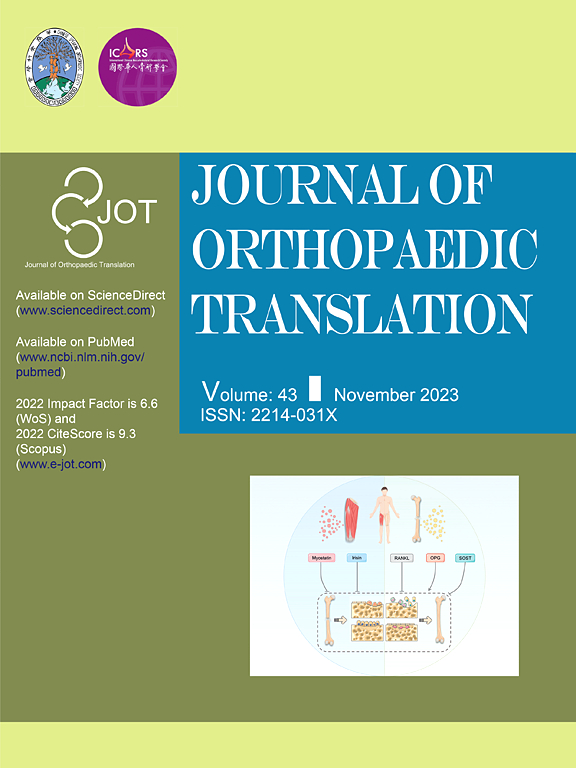Amygdalin and magnesium ions exert synergistic effects on cartilage regeneration by inhibiting chondrocyte ferroptosis via the IL-17/GPX4 axis
IF 5.9
1区 医学
Q1 ORTHOPEDICS
引用次数: 0
Abstract
Background/objective
Cartilage defects (CDs) present a significant challenge in orthopaedic medicine. Owing to the inherently limited regenerative capacity of cartilaginous tissue, defects usually do not heal via natural repair processes. Consequently, damaged tissue is replaced by fibrocartilage-like tissues instead of the original hyaline cartilage. Therefore, inhibiting fibrocartilage formation while promoting hyalinisation may represent a novel strategy for CD therapy. Although studies have explored the role of interleukin (IL)-17A and ferroptosis in the fibrosis of visceral organs, such as the liver, lungs, and kidneys, their implication in cartilage fibrosis and fibrocartilage formation remains unclear. Herein, we aimed to determine whether IL-17A and ferroptosis are collectively involved in the process of cartilage fibrosis and to investigate the effects of amygdalin (AMD) and magnesium ions (Mg2+) in cartilage regeneration and the potential molecular mechanisms underlying these effects.
Methods
Cartilage samples were collected from patients with osteoarthritis and subjected to immunohistochemistry analysis to assess fibrocartilage formation indicators within the degenerated areas. Quantitative real-time polymerase chain reaction, western blot, and immunohistochemistry analyses were employed to assess changes in cartilage anabolism and expression of fibrocartilage markers after treatment with different concentrations of AMD. We also treated chondrocytes with an IL-17A/RA antagonist, a ferroptosis inhibitor, a ferroptosis inducer, and AMD, and measured the changes in fibrocartilage-, ferroptosis-, and IL-17 signalling-associated factors. Finally, mice with microfracture (MF)-induced CDs were administered intra-articular injections of either saline, AMD (10 μmol/L), MgCl2 (0.5 mmol/L), or AMD (10 μmol/mL) plus MgCl2 (0.5 mmol/L) twice a week. After 4 and 8 weeks, chondral repair was assessed through histological and immunohistochemical analyses in each group.
Results
IL-17A activated lipid peroxidation, leading to chondrocyte ferroptosis, while AMD suppressed IL-17 signalling, thereby mitigating the decrease in glutathione peroxidase 4 (GPX4) expression induced by IL-17A or erastin. In mice with MF surgery-induced CD, the combination of AMD and Mg2+ mitigated oxidative stress, thereby enhancing the positive effects of Mg2+. This combination led to a significant improvement in chondrogenesis, activation of anabolic processes, and reduction of catabolic activity in the articular cartilage, ultimately supporting cartilage repair and regeneration.
Conclusions
AMD targets IL-17 signalling to inhibit chondrocyte ferroptosis. Furthermore, the combination of AMD and Mg2+ suppresses IL-17A/GPX4 signalling, suppressing fibrocartilage formation and fostering hyaline cartilage regeneration.
The translational potential of this article
In the present study, we showed that IL-17A may represent a promising therapeutic target for cartilage repair and regeneration. A conservative therapeutic strategy involving joint injections of AMD (a natural plant extract) and Mg2+ (a crucial endogenous factor that promotes chondrogenesis) facilitated effective cartilage repair and regeneration. This strategy represents a cost-effective approach with potential for clinical application.

苦杏仁苷和镁离子通过IL-17/GPX4轴抑制软骨细胞铁下垂,协同作用于软骨再生
背景/目的软骨缺损(cd)是骨科医学的一个重大挑战。由于软骨组织固有的有限再生能力,缺陷通常不能通过自然修复过程愈合。因此,受损组织被纤维软骨样组织取代,而不是原来的透明软骨。因此,在促进透明化的同时抑制纤维软骨的形成可能是一种新的乳糜泻治疗策略。虽然研究已经探讨了白细胞介素(IL)-17A和铁下垂在内脏器官(如肝、肺和肾)纤维化中的作用,但它们在软骨纤维化和纤维软骨形成中的意义尚不清楚。在此,我们旨在确定IL-17A和铁下垂是否共同参与软骨纤维化过程,并研究苦杏仁苷(AMD)和镁离子(Mg2+)在软骨再生中的作用及其潜在的分子机制。方法采集骨性关节炎患者软骨标本,采用免疫组化方法评价退行性关节炎区纤维软骨形成指标。采用定量实时聚合酶链反应、western blot和免疫组织化学分析评估不同浓度AMD治疗后软骨合成代谢和纤维软骨标志物表达的变化。我们还用IL-17A/RA拮抗剂、铁下垂抑制剂、铁下垂诱导剂和AMD治疗软骨细胞,并测量了纤维软骨、铁下垂和IL-17信号相关因子的变化。最后,对微骨折(MF)诱导的CDs小鼠关节内注射生理盐水、AMD (10 μmol/L)、MgCl2 (0.5 mmol/L)或AMD (10 μmol/mL)加MgCl2 (0.5 mmol/L),每周两次。4周和8周后,通过组织学和免疫组织化学分析评估各组软骨修复情况。结果IL-17A激活脂质过氧化,导致软骨细胞铁下垂,而AMD抑制IL-17信号传导,从而减轻IL-17A或erastin诱导的谷胱甘肽过氧化物酶4 (GPX4)表达下降。在MF手术诱导的CD小鼠中,AMD和Mg2+联合使用可减轻氧化应激,从而增强Mg2+的积极作用。这种组合导致软骨形成的显著改善,合成代谢过程的激活,以及关节软骨分解代谢活性的降低,最终支持软骨修复和再生。结论samd可靶向IL-17信号通路抑制软骨细胞铁下垂。此外,AMD和Mg2+联合抑制IL-17A/GPX4信号传导,抑制纤维软骨形成,促进透明软骨再生。在本研究中,我们发现IL-17A可能是软骨修复和再生的一个有希望的治疗靶点。保守的治疗策略包括关节注射AMD(一种天然植物提取物)和Mg2+(一种促进软骨形成的关键内源性因子),促进了有效的软骨修复和再生。该策略是一种具有成本效益的方法,具有临床应用潜力。
本文章由计算机程序翻译,如有差异,请以英文原文为准。
求助全文
约1分钟内获得全文
求助全文
来源期刊

Journal of Orthopaedic Translation
Medicine-Orthopedics and Sports Medicine
CiteScore
11.80
自引率
13.60%
发文量
91
审稿时长
29 days
期刊介绍:
The Journal of Orthopaedic Translation (JOT) is the official peer-reviewed, open access journal of the Chinese Speaking Orthopaedic Society (CSOS) and the International Chinese Musculoskeletal Research Society (ICMRS). It is published quarterly, in January, April, July and October, by Elsevier.
 求助内容:
求助内容: 应助结果提醒方式:
应助结果提醒方式:


